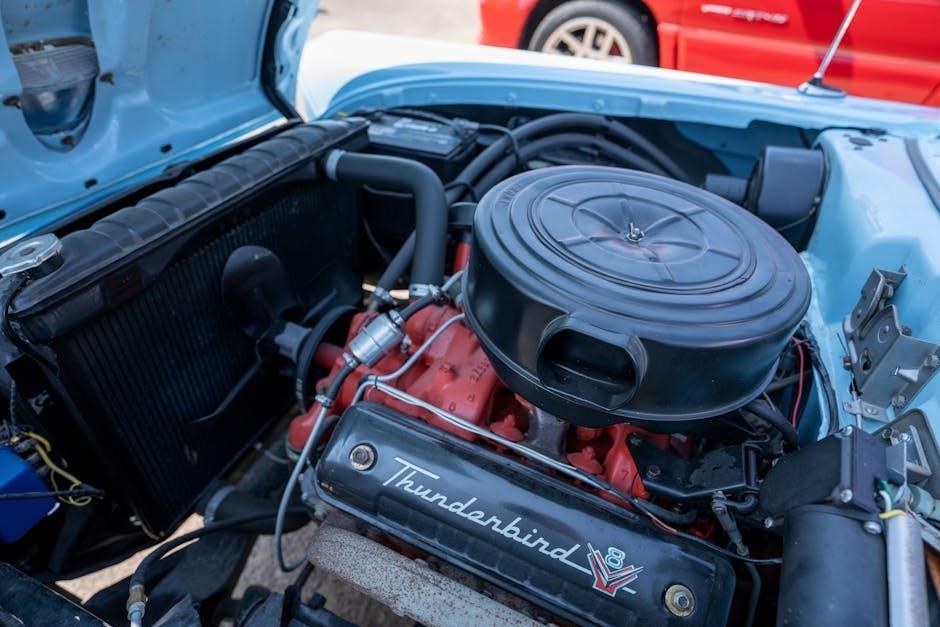This manual provides essential guidance for the safe and efficient operation of Ingersoll Rand air compressors‚ covering installation‚ maintenance‚ and troubleshooting for optimal performance and longevity.
1.1 Importance of the Manual for Safe Operation
The Ingersoll Rand air compressor manual is crucial for ensuring safe and efficient operation. It provides detailed safety guidelines to minimize risks and prevent accidents. Proper installation‚ maintenance‚ and troubleshooting procedures are outlined to avoid potential hazards. Adhering to the manual ensures compliance with international safety standards‚ safeguarding both operators and equipment. Regular reference to this manual helps maintain optimal performance and longevity of the compressor. It serves as a comprehensive guide for all users‚ emphasizing safety and proper practices throughout.
1.2 Overview of the Ingersoll Rand Air Compressor Models
Ingersoll Rand offers a diverse range of air compressor models‚ including rotary screw‚ reciprocating‚ and centrifugal types‚ catering to various industrial and commercial needs. These models are designed for durability‚ efficiency‚ and reliability‚ ensuring optimal performance in demanding environments. From portable units to large-scale industrial compressors‚ the lineup provides solutions for applications requiring consistent air pressure and flow. The manual covers technical specifications‚ key features‚ and maintenance requirements for each model‚ helping users select the right compressor for their operations. This overview highlights the versatility and innovation of Ingersoll Rand’s compressor portfolio.

Safety Guidelines and Precautions
Always follow safety guidelines to prevent accidents and ensure safe operation. Wear protective gear‚ avoid overloading‚ and keep the area well-ventilated. Refer to the manual for detailed precautions.
2.1 General Safety Instructions
Adhering to safety guidelines is crucial for safe operation. Always wear protective gear‚ including safety glasses and gloves‚ when working with the compressor. Ensure the installation area is well-ventilated to prevent accumulation of hazardous fumes. Regularly inspect the unit for wear or damage‚ addressing issues promptly. Follow proper startup and shutdown procedures to avoid sudden pressure changes. Keep loose clothing and long hair tied back to prevent entanglement in moving parts. Never overload the compressor beyond its rated capacity‚ as this can lead to malfunction. By following these instructions‚ you minimize risks and ensure reliable performance. Neglecting safety precautions may void the warranty and increase liability risks.
2.2 Specific Safety Warnings for Air Compressors
Ingersoll Rand air compressors are not designed for breathing air applications. Ensure the compressor is mounted on a stable‚ flexible system to prevent detachment and vibration damage. Always follow the manufacturer’s guidelines for operation and maintenance to avoid hazards. Never modify the compressor’s safety features or bypass protective devices. Properly isolate the compressor package from the carrier base to maintain stability and prevent accidents. Adhere to all local and international safety standards for compressed air systems. Failure to comply with these warnings may result in equipment damage‚ personal injury‚ or legal consequences. Always prioritize safety when handling compressed air equipment.
2.3 Emergency Procedures and First Aid
In case of an emergency‚ immediately shut off the compressor and disconnect the power supply. For injuries involving compressed air‚ seek medical attention promptly. If oil or coolant comes into contact with skin or eyes‚ flush with water for at least 15 minutes and seek medical help. In case of electrical malfunction‚ avoid contact with the equipment and contact a qualified technician. Properly ventilate the area if a gas leak occurs. Always maintain a first aid kit nearby and ensure personnel are trained in emergency response procedures. Regularly review and update emergency protocols to ensure preparedness and compliance with safety standards.

Installation and Setup of the Air Compressor
Ensure proper installation by selecting a well-ventilated location‚ mounting the compressor securely‚ and following manual guidelines for correct placement and connection of components for optimal performance and safety.
3.1 Choosing the Right Location
Selecting the right location for your Ingersoll Rand air compressor is crucial for efficient operation and safety. Ensure the area is well-ventilated to prevent overheating and moisture buildup. The compressor should be placed on a stable‚ level surface away from direct sunlight and extreme temperatures. Maintain a minimum clearance of 15 inches around the unit for proper air circulation. Isolate the compressor from vibrations by using a flexible mounting system to prevent damage and noise transmission. Avoid areas exposed to hazardous materials or sparks to ensure compliance with safety standards. Proper placement enhances performance and longevity of the equipment.
3.2 Unpacking and Initial Inspection
Carefully unpack the Ingersoll Rand air compressor from its shipping container to avoid damage. Inspect the unit for any visible damage or dents that may have occurred during transit. Check for completeness by verifying all components‚ such as the compressor unit‚ manuals‚ and accessories‚ are included. Ensure the compressor is clean and free from debris. Visually inspect hoses‚ connections‚ and fittings for any signs of wear or damage. Before proceeding with installation‚ confirm that all parts are in good condition to ensure safe and proper operation. Address any issues immediately to prevent future complications.
3.3 Physical Installation and Mounting
Mount the Ingersoll Rand air compressor on a stable‚ level surface to ensure proper operation and minimize vibration. Use a flexible mounting system to isolate the compressor from the base‚ preventing detachment and reducing noise. Position the unit with the belt side facing away from walls‚ maintaining at least 15 inches of clearance for adequate air circulation. Secure the compressor firmly using anchor bolts or equivalent fasteners. Ensure all connections are tight and aligned correctly. Proper installation prevents operational issues and extends the compressor’s lifespan. Always follow manufacturer guidelines for precise mounting specifications.
3.4 Connecting the Air Intake and Discharge Piping
Connect the air intake and discharge piping according to the manufacturer’s specifications and local regulations. Ensure the intake piping is free from blockages and contaminants to maintain optimal airflow. Use appropriate materials and sizes for the piping to prevent pressure drops and leaks. Secure all connections tightly to avoid vibration damage. Install a condensate trap and safety valve on the discharge line to manage moisture and ensure safe operation. Always test the system for leaks before startup. Proper piping connections are critical for efficient performance and compliance with safety standards. Follow the manual’s guidelines for detailed instructions and diagrams.

Operational Instructions
This section provides detailed guidance on starting the compressor‚ monitoring its performance‚ and following proper shutdown procedures to ensure safe and efficient operation at all times.
4.1 Starting the Compressor for the First Time
Before starting the compressor‚ ensure the area is clear of obstructions and the unit is properly installed. Inspect all components‚ including air filters and oil levels‚ to ensure they are in good condition. Connect the power supply as specified in the manual and ensure all controls are in the correct starting position. Turn on the power and follow the sequence for initial startup‚ monitoring for any unusual noises or vibrations. Allow the compressor to build up pressure gradually and check for leaks in the piping system. Refer to the manual for specific startup procedures tailored to your model.
4.2 Daily Operation and Monitoring
During daily operation‚ monitor pressure gauges to ensure they remain within the recommended range. Regularly inspect the air filter and compressor oil levels‚ topping up as needed. Check for any signs of leaks in the piping system and address them promptly to maintain efficiency. Ensure proper airflow by keeping the surrounding area clean and well-ventilated. Perform a visual inspection of all components‚ including belts and hoses‚ for wear or damage. Keep a log of operating hours and maintenance activities to track the compressor’s performance and plan scheduled upkeep. Always adhere to the manufacturer’s guidelines for optimal functionality and safety.
4.3 Proper Shutdown Procedures
Turn off the power supply to the compressor and allow it to cool down completely. Relieve any residual pressure in the system by opening the drain valves. Inspect the compressor and piping for any leaks or damage. Secure all connections and ensure the area around the compressor is clear of obstacles. Document any maintenance needs or issues observed during operation. Prepare the compressor for restart by checking fluid levels and ensuring all components are in good working condition. Always follow the manufacturer’s specific shutdown instructions to ensure safety and prevent damage to the equipment.

Maintenance and Troubleshooting
This section outlines routine maintenance tasks and troubleshooting techniques to ensure optimal performance and longevity of your Ingersoll Rand air compressor‚ following manufacturer guidelines for safe and efficient operation.
5.1 Routine Maintenance Tasks
- Regularly check and top up the oil levels to ensure proper lubrication and prevent wear.
- Inspect and replace air filters to maintain airflow efficiency and prevent contamination.
- Check the belt tension and alignment to avoid misalignment issues and ensure smooth operation.
- Drain condensate from the tank and traps to prevent rust and corrosion.
- Inspect the discharge piping for leaks or blockages to ensure safe and efficient operation.
- Follow the recommended maintenance schedule outlined in the manual for optimal performance.
5.2 Common Issues and Troubleshooting Techniques
Addressing common issues promptly ensures reliable operation. Low pressure or airflow can result from clogged filters‚ faulty regulators‚ or pipe leaks. Abnormal noises may indicate loose belts‚ misaligned pulleys‚ or worn components. Excessive oil leakage could stem from damaged seals or gaskets. Overheating often occurs due to insufficient cooling‚ high ambient temperatures‚ or blocked air intakes. For these issues‚ inspect and clean filters‚ tighten loose parts‚ and replace worn or damaged components. Always refer to the troubleshooting guide in the manual for specific instructions and solutions to restore optimal performance and prevent further damage. Regular checks can help identify and resolve problems early.
5.3 Replacement of Parts and Components
Replacing parts and components requires careful planning and adherence to manufacturer guidelines. Always use genuine Ingersoll Rand parts to ensure compatibility and performance. Refer to the detailed parts manual for specific instructions and diagrams. Before replacement‚ isolate the compressor and follow proper safety protocols. Mounting systems should be flexible to prevent detachment and ensure stability. Replace worn or damaged components promptly to avoid further damage. Use the correct tools and follow torque specifications for bolts and fasteners. After replacement‚ test the system under no-load conditions to verify proper operation. Regular replacement of filters‚ oil‚ and seals maintains efficiency and extends equipment life. Always consult the manual for specific part numbers and procedures to ensure safe and effective replacements. Proper installation and testing are crucial for optimal performance and longevity.

Technical Specifications and Data
This section outlines the key technical features‚ performance metrics‚ and operational limits of Ingersoll Rand air compressors‚ ensuring efficient and reliable operation across various applications and environments.
6.1 Key Technical Features of Ingersoll Rand Air Compressors
Ingersoll Rand air compressors are engineered for durability and efficiency‚ featuring advanced cooling systems‚ robust construction‚ and variable speed drives. They incorporate cutting-edge technology to minimize energy consumption while delivering consistent performance. Key features include oil-free operation‚ noise-reducing designs‚ and intelligent control systems for optimal monitoring. These compressors are built to withstand demanding environments and ensure reliable operation across various industries. Their compact designs and lightweight structures enhance portability‚ making them suitable for diverse applications. With a focus on innovation‚ Ingersoll Rand compressors are designed to meet stringent quality standards‚ ensuring long-term productivity and reduced maintenance needs.
6.2 Performance Metrics and Operational Limits
Ingersoll Rand air compressors deliver exceptional performance with precise metrics‚ ensuring reliable operation within specified limits. They offer a range of pressure and flow rate options to suit diverse applications. Operational limits include maximum temperature thresholds‚ duty cycles‚ and recommended ambient conditions. The compressors are designed to maintain consistent output while minimizing energy consumption. Adherence to these limits ensures optimal performance‚ reduces wear‚ and extends equipment lifespan. Proper monitoring of these metrics is crucial for maintaining efficiency and safety‚ as outlined in the manual. Always refer to the technical specifications for your model to ensure compliance with operational guidelines.
6.3 Compatibility with Accessories and Ancillary Equipment
Ingersoll Rand air compressors are designed to work seamlessly with a range of accessories and ancillary equipment. Compatible components include air filters‚ dryers‚ and drain traps‚ ensuring optimal performance. The manual specifies approved parts and configurations to maintain efficiency and safety. Properly matched accessories prevent contamination and maintain air quality. Using genuine Ingersoll Rand parts guarantees compatibility and adherence to operational standards. Always consult the manual or contact Ingersoll Rand support for recommendations on ancillary equipment to ensure system integrity and reliability. This ensures your compressor operates at peak performance under all conditions.

Understanding the Manual’s Structure
The manual is organized into clear chapters and subheadings‚ with reference tables‚ diagrams‚ and an index for easy navigation and quick access to specific information.
7.1 Navigating the Manual for Quick Reference
The manual is designed with a clear structure to help users quickly find information. The table of contents provides an overview of major sections‚ while detailed chapters are divided into subheadings for easy access. Reference tables‚ charts‚ and diagrams are included to simplify complex topics. Users can locate specific guidance using the index‚ which lists key terms and topics alphabetically. Technical drawings and illustrations are also provided to visually explain procedures and components. For digital versions‚ a search function or bookmarks can be used to navigate directly to relevant sections‚ ensuring efficient access to critical information when needed.
7.2 Interpretation of Technical Drawings and Diagrams
Technical drawings and diagrams in the manual provide visual guidance for understanding compressor components and their relationships. These illustrations detail assembly‚ disassembly‚ and maintenance procedures‚ ensuring clarity for users; Labels and color coding help identify parts and their functions‚ while symbols and flowcharts explain operational processes. Cross-sectional views offer insights into internal mechanics‚ aiding in troubleshooting and repairs. By referencing these visuals‚ users can better comprehend complex systems and perform tasks safely and effectively. Always refer to the accompanying text for context and specific instructions related to the diagrams.
7.3 Reference Tables and Charts for Easy Lookup
Reference tables and charts in the manual are designed to provide quick access to critical information‚ ensuring efficient operation and troubleshooting. These include part numbers‚ torque specifications‚ and conversion formulas. Maintenance schedules and troubleshooting guides are presented in clear‚ organized charts‚ helping users identify and resolve issues rapidly. Pressure-temperature tables and flow rate diagrams further assist in optimizing compressor performance. These resources enable users to locate essential data without navigating the entire manual‚ enhancing productivity and reducing downtime. Always cross-reference with the index to ensure accurate and efficient use of the provided tables and charts.

Environmental and Regulatory Considerations
Ingersoll Rand air compressors comply with international environmental standards‚ ensuring minimal ecological impact. Proper waste disposal and energy-efficient designs reduce environmental footprint while meeting regulatory requirements.
8.1 Compliance with International Standards
Ingersoll Rand air compressors are designed to meet rigorous international standards‚ ensuring safety‚ efficiency‚ and environmental compliance. These compressors adhere to ISO and CE certifications‚ among others‚ guaranteeing adherence to global quality benchmarks. The equipment is manufactured with materials and processes that comply with environmental regulations‚ minimizing ecological impact. Energy efficiency is prioritized to align with global sustainability goals. By following these standards‚ Ingersoll Rand ensures reliable performance while promoting eco-friendly practices. This compliance not only meets regulatory requirements but also supports responsible industrial operations worldwide.
8.2 Waste Disposal and Recycling Guidelines
Ingersoll Rand air compressors require responsible waste disposal and recycling practices to minimize environmental impact. Proper procedures for disposing of used filters‚ oils‚ and metallic components are outlined in the manual. Users are advised to comply with local regulations and use authorized recycling facilities. Recycling of materials like steel‚ aluminum‚ and plastics is encouraged to conserve resources and reduce landfill waste. By adhering to these guidelines‚ users can contribute to sustainable practices while ensuring compliance with environmental laws. Proper disposal and recycling help maintain eco-friendly operations and promote a greener future for industrial equipment.
8.3 Energy Efficiency and Environmental Impact
Ingersoll Rand air compressors are designed with energy efficiency in mind to reduce environmental impact. The manual emphasizes the importance of optimizing energy use and minimizing waste. Advanced technologies‚ such as variable speed drives‚ help lower power consumption while maintaining performance. Proper maintenance practices‚ like regular filter cleaning and oil changes‚ also contribute to energy savings. By adhering to the manual’s guidelines‚ users can reduce their carbon footprint and promote sustainable operations. Ingersoll Rand encourages eco-friendly practices to ensure their compressors operate efficiently while supporting environmental conservation efforts and compliance with global energy standards.

Warranty and Support Information
Ingersoll Rand provides comprehensive warranty coverage and dedicated support services. The manual details warranty terms‚ contact information‚ and access to online resources for assistance and documentation.
9.1 Warranty Coverage and Terms
Ingersoll Rand warrants its portable air compressors to be free from defects in material and workmanship. The warranty period varies by product and is valid for the initial user. Coverage includes parts and labor under specified conditions. The manual outlines detailed terms‚ including what is covered and for how long. Certain conditions‚ such as misuse or unauthorized modifications‚ may void the warranty. Users are advised to review the manual for full terms and conditions to ensure compliance and maintain coverage. This ensures optimal protection for your investment in Ingersoll Rand air compressors.
9.2 Contacting Ingersoll Rand Support
For assistance‚ contact Ingersoll Rand support through their official website or authorized distributors. The manual provides contact details‚ including phone numbers and email addresses. Users can access technical support‚ troubleshooting‚ and service requests. Additionally‚ the Document Library offers downloadable resources‚ such as manuals and brochures. Ensure to have your product model number ready for efficient service. Ingersoll Rand’s support team is dedicated to resolving queries and providing expert guidance‚ ensuring your compressor operates at peak performance. Reach out for any concerns or inquiries related to your air compressor.
9.3 Accessing Online Resources and Documentation
Ingersoll Rand provides comprehensive online resources for easy access to manuals‚ technical drawings‚ and product information. Users can visit the official Ingersoll Rand website or the Document Library‚ which includes CAD drawings‚ brochures‚ MSDS‚ and warranty guides. The Compressed Air & Gas Institute (CAGI) Data Sheet Library is also available for additional technical details. For specific models like R4i‚ R5.5i‚ and R7.5i‚ detailed parts information and release notes are accessible. These resources ensure users can stay updated on product specifications‚ troubleshooting‚ and maintenance‚ optimizing their air compressor’s performance and longevity.

Appendices and Additional Resources
The appendices provide supplementary materials‚ including a glossary of technical terms‚ conversion tables‚ and a list of approved service providers for further assistance and reference.
10.1 Glossary of Technical Terms
The glossary provides clear definitions of technical terms and abbreviations used throughout the manual‚ ensuring users understand key concepts like pressure‚ flow rates‚ and compressor components effectively‚ enhancing their ability to operate and maintain the equipment properly.
10.2 Conversion Tables and Formulas
This section provides essential conversion tables and formulas to help users perform calculations related to air compressor operations. It includes unit conversions‚ pressure calculations‚ and formulas for determining flow rates and power requirements. These tools simplify technical tasks‚ ensuring accurate setup and maintenance. The tables cover common measurements such as PSI to bar‚ CFM to m³/h‚ and horsepower to kW. Formulas are provided for calculating compressor efficiency‚ discharge pressure‚ and energy consumption. This resource aids in troubleshooting and optimizing performance‚ aligning with industry standards for safety and efficiency.
10.3 List of Approved Service Providers
This section contains a comprehensive list of Ingersoll Rand-approved service providers‚ ensuring users access authorized maintenance and repair services. These providers are certified to deliver genuine parts and expertise‚ maintaining compliance with safety and performance standards. Using approved providers prevents counterfeit parts and ensures warranty validity. The list includes contact details and regional coverage‚ helping users locate trusted support quickly. This resource guarantees reliable service‚ minimizing downtime and ensuring optimal compressor performance. It is crucial for maintaining operational efficiency and safety‚ adhering to Ingersoll Rand’s quality standards.
Proper use and maintenance of your Ingersoll Rand air compressor ensure optimal performance and safety. Regularly review the manual and utilize Ingersoll Rand’s support resources for assistance. Thank you.
11.1 Recap of Key Points
The Ingersoll Rand air compressor manual emphasizes safety‚ proper installation‚ and regular maintenance for optimal performance. Key points include adhering to safety guidelines‚ ensuring correct setup‚ and performing routine checks. Understanding operational limits and troubleshooting common issues is crucial. Regular maintenance‚ such as fluid checks and filter replacements‚ prolongs equipment life. Always refer to the manual for detailed instructions and technical specifications. By following these guidelines‚ users can ensure reliable operation‚ minimize downtime‚ and maintain compliance with safety standards. Proper shutdown procedures and emergency preparedness are also vital for safe and efficient compressor operation.
11.2 Final Tips for Optimal Compressor Performance
For optimal performance‚ always follow the manual’s guidelines‚ ensuring proper installation and regular maintenance. Check fluid levels‚ clean filters‚ and inspect piping regularly. Monitor performance metrics and address issues promptly to prevent downtime. Proper shutdown procedures and scheduled servicing by certified professionals can extend the compressor’s lifespan. Refer to technical specifications for compatibility and operational limits. Stay updated with the latest safety and efficiency standards to ensure reliable operation. By adhering to these tips‚ users can maximize their compressor’s efficiency‚ reduce wear and tear‚ and maintain a safe working environment.
11.3 Encouragement for Continuous Learning
Continuous learning is key to mastering air compressor operation and maintenance; Users are encouraged to explore additional resources‚ such as online tutorials‚ manufacturer updates‚ and industry workshops. Staying informed about new technologies and best practices enhances efficiency and safety. Regularly reviewing the manual and seeking expert advice ensures compliance with evolving standards. By committing to ongoing education‚ operators can optimize compressor performance‚ troubleshoot effectively‚ and contribute to a safer‚ more productive work environment. Ingersoll Rand supports this journey with accessible documentation and expert support‚ fostering a culture of knowledge and improvement.

Leave a Reply
You must be logged in to post a comment.